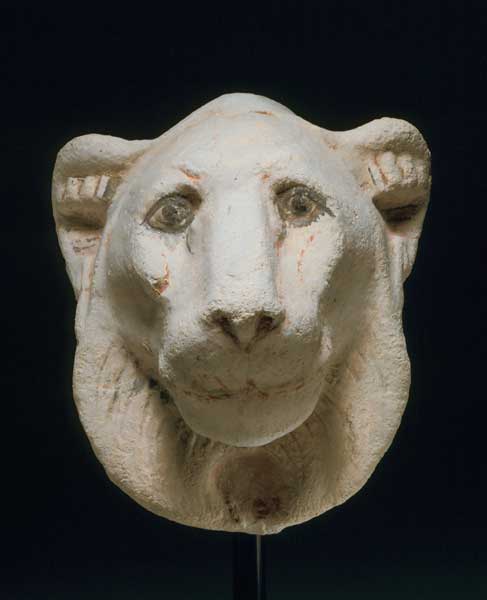Egyptian Stucco Model of the Head of a Lioness, 664 BCE - 525 BCE
Stucco
height 19.1 cm
height 7 1/2 in
height 7 1/2 in
X.0354
It is believed that some stucco works such as this one functioned as aids for apprentices to learn the art of sculpting before embarking upon royal commissions where one mistake...
It is believed that some stucco works such as this one functioned as aids for apprentices to learn the art of sculpting before embarking upon royal commissions where one mistake could mean disaster. Similar pieces were unearthed in what are thought to have been artist workshops, thus their identification as models. Considering the stylization of Egyptian art, it is clear that there was not much room for individual interpretation. When one realizes that many sculptors would have been responsible for decorating a single tomb or temple, stylistic unity becomes a foremost concern. Today, these sculptures give us unique insight into the creative process behind some of the most endearing and enduring artworks ever created by mankind.
The lion is a symbol of strength and ferocity. The largest of the cat family, this animal is known as the “king of the beasts.” They are equally feared and respected for their power, speed, and intimidating growl. Kings and rulers have associated themselves with this noble creature since the days of antiquity. However, the lack of a bushy mane on this stucco work indicates that it represents a lioness. Therefore, it is probable that this head was a sculptor’s model employed during the manufacturing of Sekhmet sculptures.
Sekhmet, along with her husband the creator-god Ptah and their son Nerfertum, was part of the powerful trio of deities that protected Ancient Memphis. She was a sun goddess, embodying the scorching, burning, destructive heat of the sun. Fierce goddess of war, the destroyer of the enemies of Ra and Osiris, she was represented as having the head of a lioness and the body of a woman. Like the sun, her temper was uncontrollable. In the legend of Ra and Hathor, Sekhmet's anger became so great, she would have destroyed all of mankind if Ra had not taken pity on us and made her inebriated.
Many centuries ago, a master sculptor might have corrected his apprentice by showing them such a model. A useful tool for understanding the dimensions and shape of the subject, such models would have assisted young students when natural observation was not possible. Considering the subject of this work, a lioness’ head, it is unlikely that many artists would have been keen to venture into the wild and sketch likenesses of this beast. There is a royal presence visible in the face of this lionness, suggesting that she would be a suitable model for a sculpture of the goddess Sekhmet.
The lion is a symbol of strength and ferocity. The largest of the cat family, this animal is known as the “king of the beasts.” They are equally feared and respected for their power, speed, and intimidating growl. Kings and rulers have associated themselves with this noble creature since the days of antiquity. However, the lack of a bushy mane on this stucco work indicates that it represents a lioness. Therefore, it is probable that this head was a sculptor’s model employed during the manufacturing of Sekhmet sculptures.
Sekhmet, along with her husband the creator-god Ptah and their son Nerfertum, was part of the powerful trio of deities that protected Ancient Memphis. She was a sun goddess, embodying the scorching, burning, destructive heat of the sun. Fierce goddess of war, the destroyer of the enemies of Ra and Osiris, she was represented as having the head of a lioness and the body of a woman. Like the sun, her temper was uncontrollable. In the legend of Ra and Hathor, Sekhmet's anger became so great, she would have destroyed all of mankind if Ra had not taken pity on us and made her inebriated.
Many centuries ago, a master sculptor might have corrected his apprentice by showing them such a model. A useful tool for understanding the dimensions and shape of the subject, such models would have assisted young students when natural observation was not possible. Considering the subject of this work, a lioness’ head, it is unlikely that many artists would have been keen to venture into the wild and sketch likenesses of this beast. There is a royal presence visible in the face of this lionness, suggesting that she would be a suitable model for a sculpture of the goddess Sekhmet.



